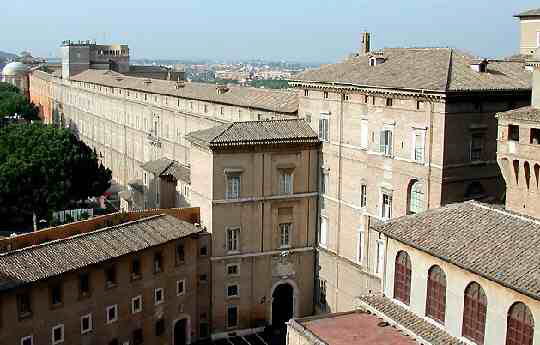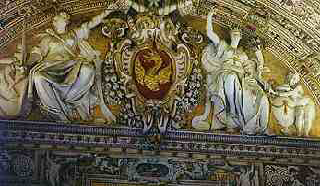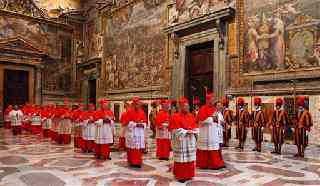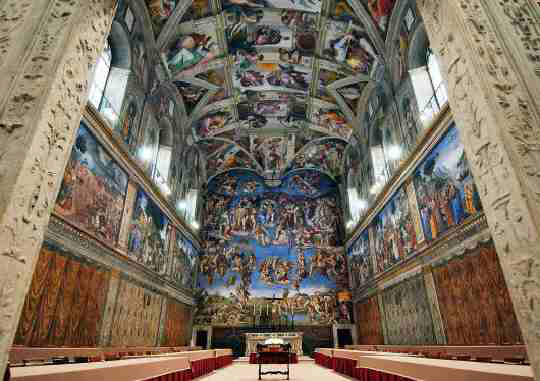
Tour of Rome
Sistine Chapel
Tourists visiting Rome will, no doubt have the Vatican at the top or very near the top of their list of "must see" sights. One of the main attractions within the Vatican is the Sistine Chapel. It is located in the southwest corner of the old medieval part of the Apostolic Palace, in the very heart of the Vatican. It takes its name from Pope Sixtus IV della Rovere. Sixtus started an ambitious programme of decoration within the chapel, by employing a team of the most prestigious artists of the day, including Botticelli, Signorelli, Ghirlandaio, Cosimo Rosselli and Perugino. Their task was to cover the upper walls with frescoes depicting episodes from the lives of Moses and Christ. The ceiling vault was painted dark blue, and covered with gold stars.

The ceiling of the Sistine Chapel is a shallow barrel vault, about 40 m long by 13 m wide, with windows in both long sides which cut into the vault so as to produce a series of pedantries between the windows, which are surrounded by lunettes, and have triangular shaped areas, called spandrels, above them at the junction of wall and ceiling. The central part of the vault is almost flat. In 1506, Pope Julius II asked Michelangelo to redecorate much of the chapel. He completed the famous ceiling frescoes in 1512 Commissioned by Julius II in 1508-
 The architectural plans for the chapel were drawn up by Baccio Pontelli, with the construction work being done between 1473 and 1484. During this time, the work was being supervised by Giovannino de Dolci. The first mass in the Sistine Chapel was celebrated on August 9, 1483, At this ceremony, the Sistine Chapel was consecrated, and dedicated to the Assumption of the Virgin Mary.
The architectural plans for the chapel were drawn up by Baccio Pontelli, with the construction work being done between 1473 and 1484. During this time, the work was being supervised by Giovannino de Dolci. The first mass in the Sistine Chapel was celebrated on August 9, 1483, At this ceremony, the Sistine Chapel was consecrated, and dedicated to the Assumption of the Virgin Mary.
 The Sistine Chapel becomes the centre of attention when the time comes to elect a new Pope. The pope is elected in a process called a "conclave." The word "conclave" is derived from two Latin words which mean "with a key." It referred to the practice of locking the cardinals in a somewhat confined space, and not allowing them to emerge until they have elected a new pope. The rules governing the conclave, have since been changed and the cardinals are no longer confined to the Sistine Chapel, for both day and night throughout the election process. They are now assigned more comfortable living quarters in a suitable location within the Vatican. For the duration of the conclave, a chimney is installed in the roof of the chapel. after each vote, the ballot papers are burnt. If the ballot was unsuccessful, then the chimney emits black smoke. Once a new Pope has been elected, the smoke emitted from the chimney is white. Nowadays, to maintain security and the secrecy of the conclave, the chapel is carefully searched to ensure there are no bugs, recorders, or cameras, present.
The Sistine Chapel becomes the centre of attention when the time comes to elect a new Pope. The pope is elected in a process called a "conclave." The word "conclave" is derived from two Latin words which mean "with a key." It referred to the practice of locking the cardinals in a somewhat confined space, and not allowing them to emerge until they have elected a new pope. The rules governing the conclave, have since been changed and the cardinals are no longer confined to the Sistine Chapel, for both day and night throughout the election process. They are now assigned more comfortable living quarters in a suitable location within the Vatican. For the duration of the conclave, a chimney is installed in the roof of the chapel. after each vote, the ballot papers are burnt. If the ballot was unsuccessful, then the chimney emits black smoke. Once a new Pope has been elected, the smoke emitted from the chimney is white. Nowadays, to maintain security and the secrecy of the conclave, the chapel is carefully searched to ensure there are no bugs, recorders, or cameras, present.

Many of the works of art within the chapel were in need of restoration, so in 1980 a programme of test cleaning and restoration work on Michelangelo's frescoes was initiated, a year later full scale work started, and was completed in 1994. After this the cleaning of the chapel frescoes by Botticelli, Perugino, and other painters was carried out, and completed in 1999.